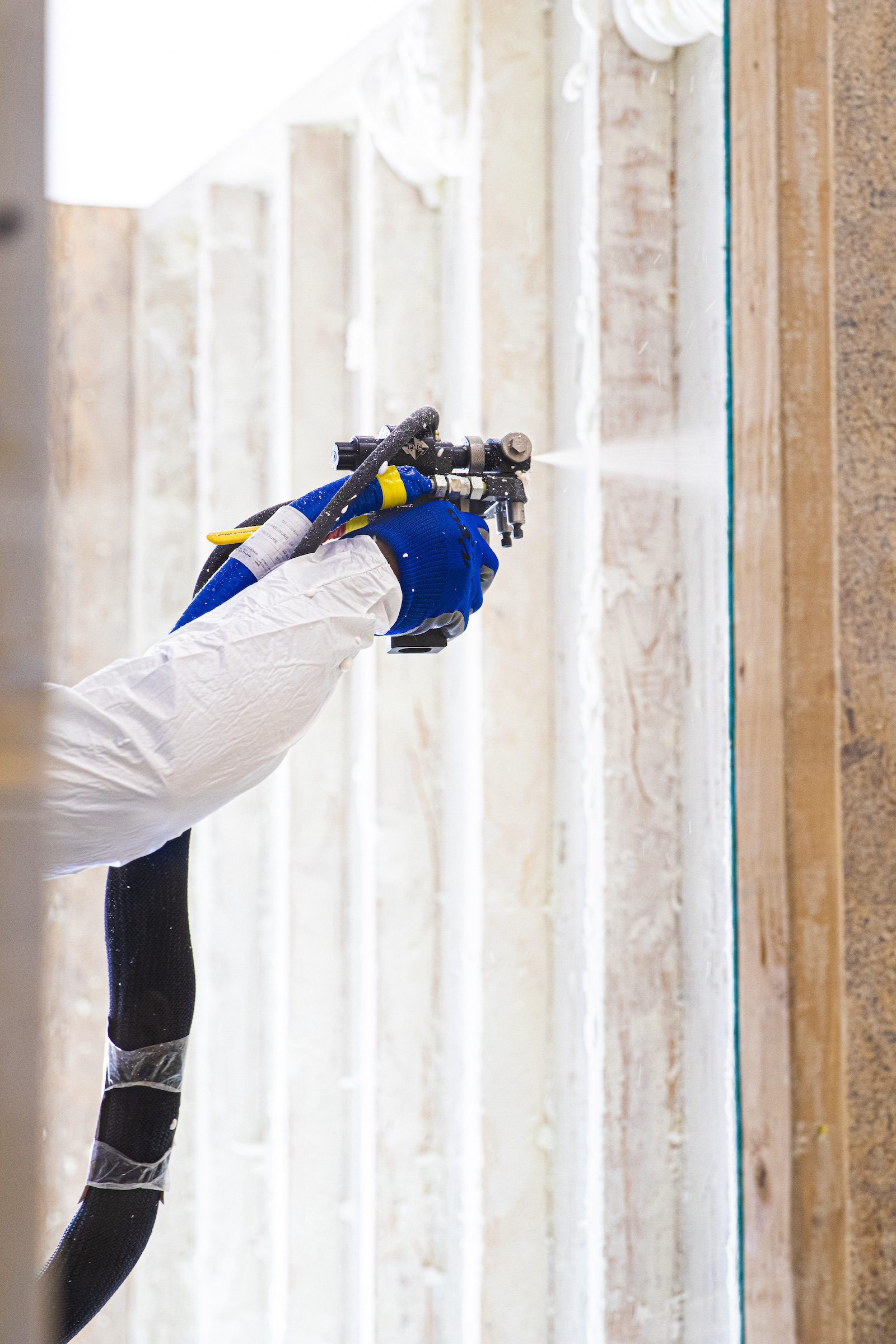How Does a Spray Foam Insulation Contractor Handle Hard to Reach Areas

Spray foam insulation is a versatile and effective solution for enhancing energy efficiency and comfort in homes and buildings. This modern insulation method involves applying a liquid foam that expands and hardens, creating an airtight seal.
However, one significant challenge contractors face is insulating hard-to-reach areas such as attics, crawl spaces, and wall cavities. These spaces are often overlooked yet crucial for preventing energy loss and maintaining indoor temperature. Addressing these areas requires specialized tools, techniques, and expertise.
In this blog post, we’ll explore the common challenges of insulating difficult spaces, the innovative solutions that spray foam insulation contractors employ, and the benefits of ensuring even the most inaccessible areas are properly insulated.
Overview Insulation and Its History
Insulation has been used for centuries to regulate indoor temperature and improve energy efficiency. In ancient times, people would use natural materials like straw, mud, and animal hair to insulate their homes. However, it wasn’t until the late 19th century that modern insulation methods started to develop.
The first recorded use of spray foam insulation was in the early 20th century when an inventor named Otto Bayer created a flexible foam material made from polyurethane. This breakthrough led to the development of various types of spray foam insulation used today.
Over time, spray foam insulation has become one of the most popular and effective ways to insulate buildings due to its versatility, durability, and energy-saving properties. And as buildings become more complex and sophisticated, the demand for spray foam insulation continues to rise.
What is Spray Foam?
Spray foam insulation is a two-part system that consists of isocyanate and polyol resin, which are mixed together at the time of application.
When these two components combine, they create a chemical reaction that causes the mixture to expand and harden quickly. The resulting foam has excellent adhesive properties and can adhere to almost any surface, making it suitable for use in various spaces.
Spray polyurethane foam alliance (SPFA) categorizes spray foam into two types: open-cell and closed-cell. Open-cell foam has a lower density and is more flexible, while closed-cell foam has a higher density and provides better insulation properties. Both types of spray foam have their unique advantages, making them suitable for different applications.
Types of Spray Foam Insulation
There are two main types of spray foam insulation: open-cell and closed-cell. Open-cell foam is typically used for interior applications such as walls, attics, and basements. It has a lower density and can expand up to 100 times its original size when sprayed, creating a spongy texture with air pockets. This type of foam is excellent for soundproofing but not as effective in preventing moisture or air infiltration compared to closed-cell foam.
On the other hand, closed-cell foam is denser and has a higher R-value (the measure of an insulation material’s thermal resistance). It is often used for exterior applications like roofs and foundations due to its ability to provide a more substantial air and moisture barrier. Closed-cell foam also has a harder, rigid texture, making it suitable for structural support.
Aside from the two main types, there are also hybrid or blended spray foams available that combine the properties of both open-cell and closed-cell foam. These types of spray foam offer a balance between insulation, air sealing, and cost-effectiveness.
High-density spray foam is another type commonly used for insulating hard-to-reach areas. It has a higher R-value and can be applied in thinner layers, making it perfect for unconventional spaces like crawl spaces and attics.
Low-density spray foam, also known as half-pound foam, is used for soundproofing and filling larger cavities. Also, It is more cost-effective but has a lower R-value compared to high-density foam.
Composition and Expansion of Spray Foam
Spray foam insulation is made up of two key components: polyol resin and isocyanate. These two chemicals are stored separately in drums or tanks until they are mixed at the time of application. The mixture is then sprayed onto surfaces, where it expands and hardens within seconds.
The expansion ratio of spray foam depends on the type being used and environmental factors such as temperature and humidity. On average, closed-cell foam expands 30-60 times its original size, while open-cell foam can expand up to 100 times.
It’s essential to have a thorough understanding of how spray foam works before attempting to use it in difficult areas. An experienced spray foam insulation contractor knows precisely how much foam to apply and the ideal expansion rate for each specific space. This knowledge is crucial in achieving optimal insulation and preventing any potential issues, such as over spraying.
How Does a Spray Foam Insulation Contractor Handle Hard to Reach Areas
One of the main challenges contractors face when it comes to insulating difficult spaces is accessibility. Attics, crawl spaces, and wall cavities are often tight, cramped, and hard-to-reach areas that require specialized tools and techniques. But with the help of a trained and experienced spray foam insulation contractor, no space is too difficult to insulate.
Firstly, contractors use specialized equipment such as long hoses, extension wands, and spray guns to reach deep into narrow areas. These tools allow them to apply the foam evenly and efficiently in even the most inaccessible spaces.
In addition to equipment, contractors also utilize specific techniques for each type of space they encounter. For example, in attics, they may use a method called “flash and batt,” which involves first spraying a thin layer of foam to seal any gaps or cracks, followed by filling the rest of the cavity with traditional fiberglass batt insulation.
For crawl spaces, contractors may opt for a different technique known as “open-cell spray foam on walls.” This method involves spraying open-cell foam directly onto masonry surfaces to create an air barrier and prevent moisture infiltration. Contractors can also apply closed-cell foam on the floor joists or walls to provide additional support and insulation.
Another commonly used technique for hard-to-reach areas is injection spray foam, where the foam is injected into small holes drilled into existing walls. This method is ideal for retrofitting older buildings or homes with existing walls that need to be insulated.
What Things Need to Be Considered Before Installing Spray Foam Insulation
Before deciding to use spray foam insulation, there are a few things that need to be considered. Firstly, it’s essential to understand the properties and characteristics of each type of foam and determine which one is best suited for the specific application.
Next, it’s crucial to assess the condition of the space being insulated. Any moisture or air leaks should be addressed before installing spray foam as it can seal in existing issues and cause further damage.
The environmental factors also play a role in determining the success of spray foam insulation. Temperature and humidity can affect the expansion rate and curing time of the foam, so it’s vital to plan accordingly when scheduling an installation. It’s also essential to ensure proper ventilation during and after the installation process.
Lastly, it’s crucial to hire a trained and experienced spray foam insulation contractor. They have the knowledge, tools, and skills necessary to properly install spray foam insulation and achieve optimal results. Plus, they can provide expert advice on any potential issues or considerations specific to the project.
Case Studies or Examples
To further illustrate the effectiveness and versatility of spray foam insulation, here are some case studies or examples:
- Insulating a Historic Home: A historic home in New York City needed an energy-efficient solution to reduce heating and cooling costs while preserving its historical integrity. The homeowners opted for spray foam insulation as it allowed for customization and provided excellent air sealing properties without compromising the aesthetics of the home.
- Soundproofing a Recording Studio: A recording studio in Los Angeles was struggling with outside noise infiltrating their space, affecting sound quality. They chose open-cell spray foam to fill gaps between walls and create an effective sound barrier, resulting in improved acoustics within the studio.
- Retrofitting a Commercial Building: A commercial building in Chicago needed to be retrofitted with insulation to meet energy code requirements. Closed-cell spray foam was used as it provided high R-value and superior air sealing properties, effectively reducing the building’s energy consumption.
These case studies demonstrate how spray foam insulation can be tailored to various needs and applications, making it an ideal choice for many projects. By understanding its composition, application techniques, and considerations before installation, contractors can provide optimal results for their clients in any space.
What Tools and Equipment Used in Spray Foam Insulation
Spray foam insulation requires specialized tools and equipment to properly mix and apply the foam onto surfaces. These tools not only make the spray foam jobs easier for contractors but also ensure that the foam is applied evenly and efficiently, resulting in optimal insulation.
One of the primary pieces of equipment used in spray foam insulation is a spray gun. This gun has a nozzle attached to it, which allows for controlled spraying of the foam onto surfaces. The spray gun also has a trigger mechanism that controls the flow and mixture of the two chemicals – polyol resin and isocyanate.
To reach difficult or tight spaces, contractors use long hoses and extension wands with their spray guns. These extensions allow them to reach deep into cavities and spray the foam evenly. They also have a range of nozzle sizes to choose from, depending on the type of foam and application technique being used.
Another essential piece of equipment is the proportioner. This machine meters and mixes the two chemicals in the correct ratio for optimal expansion and curing. Proportioners come in different sizes, depending on the scale of the project. For smaller projects, a portable proportioner may be used, while larger commercial projects may require a truck-mounted unit.
Safety equipment is also necessary when working with spray foam insulation due to its chemical components. Contractors must wear protective gear such as respirators, goggles, gloves, and coveralls to prevent any harm from exposure to the chemicals.
Spray foam insulation requires specialized tools and equipment and is best left to trained and experienced contractors.
What are the Techniques for Effective Insulation
To achieve effective insulation, there are various techniques that contractors can use when applying spray foam. These methods not only ensure proper coverage of the space but also help prevent any potential issues such as over spraying.
One technique commonly used is called “flash and batt,” where a thin layer of spray foam is first applied to seal any gaps or cracks in the space, followed by filling the rest of the cavity with traditional fiberglass batt insulation. This method provides both air sealing and thermal insulation, making it ideal for attics.
For crawl spaces, contractors may use the “open-cell spray foam on walls” technique. This involves directly spraying open-cell foam onto masonry surfaces to create an air barrier and prevent moisture infiltration. Closed-cell foam may also be applied on the floor joists or walls for additional support and insulation.
In hard-to-reach areas, contractors may use injection spray foam, where small holes are drilled into existing walls, and the foam is injected for insulation. This method is suitable for retrofitting older buildings with existing walls that need to be insulated.
Ultimately, the key to effective insulation lies in a contractor’s experience and understanding of spray foam properties and application techniques. By using the right tools and choosing the appropriate technique for each space, contractors can achieve optimal results for their clients.
How Much Maintenance Does Spray Foam Equipment Require?
Like any other equipment, spray foam tools and machines require regular maintenance to ensure they operate efficiently and last longer. Neglecting maintenance can lead to decreased performance, higher energy costs, and even potential safety hazards. Here are some essential maintenance tasks that should be performed on spray foam equipment regularly:
Cleaning
Regularly cleaning the spray gun, hoses, proportioner, and other equipment is crucial for their long-term functionality. After each use, the gun should be flushed with a designated solvent or water to remove any remaining chemical residue. The hoses and proportioner should also be flushed according to manufacturer instructions to prevent clogging or buildup.
Changing Filters
Filters in the proportioner need to be changed periodically to prevent contamination and ensure proper chemical mixture. These filters can become clogged with debris, causing issues with the foam’s quality and expansion rate. It’s essential to check the filters regularly and replace them as needed.
Moreover, intake filters on compressors and ventilation systems should also be maintained to prevent dust and debris from entering the system. These filters need to be changed or cleaned regularly to maintain proper airflow and prevent any issues with the equipment’s
performance.
Lubricating Moving Parts
Spray foam equipment has many moving parts that require regular lubrication to prevent wear and tear. This includes o-rings, pistons, and valves in the spray gun, as well as bearings in the proportioner. Using a designated lubricant can help keep these parts functioning smoothly and prevent any potential breakdowns or malfunctions.
Inspecting for Wear and Tear
Regularly inspecting all components of spray foam equipment is crucial for catching any signs of wear and tear early on. This includes checking for cracks or damage in hoses, worn out seals in the spray gun, and any leaks or strange noises coming from the proportioner. Catching these issues early can prevent more significant problems down the line.
Conducting Routine Maintenance
In addition to regular cleaning and inspections, it’s essential to follow manufacturer guidelines for routine maintenance tasks. This may include changing pump packing on a schedule, replacing valves or o-rings, and calibrating the proportioner regularly.
Keeping up with maintenance not only ensures optimal performance but also helps extend the lifespan of spray foam equipment. It’s important to keep detailed records of all maintenance tasks performed and address any issues immediately to prevent costly repairs in the future. Consulting with a professional technician can also help ensure that all maintenance tasks are done correctly and efficiently.
Why Are More People Choosing Spray Foam for Their Homes?
There has been a significant increase in the popularity of spray foam insulation in recent years, with more and more homeowners choosing it for their homes. But what makes this type of insulation so attractive? Here are some reasons why homeowners are turning to spray foam for their residential properties:
Energy Efficiency
One major factor driving the popularity of spray foam is its high energy efficiency. Unlike traditional insulation materials like fiberglass or cellulose, which simply provide a barrier against heat transfer, spray foam creates an air-tight seal that prevents any air leakage. This means that less energy is needed to heat or cool the home, resulting in lower energy bills.
Moreover, because of its high R-value (a measure of thermal resistance), spray foam can provide better insulation using thinner layers compared to traditional materials. This is particularly beneficial for homes with limited space or those that need to meet specific building codes.
Air Sealing
As mentioned, spray foam creates an air-tight seal, making it a highly effective solution for preventing air leakage. Air leakage occurs when gaps and cracks in the walls, floors, or roof allow outside air to enter the home, resulting in drafts and temperature fluctuations. By filling these gaps and cracks, spray foam not only improves energy efficiency but also provides better indoor air quality by keeping out pollutants and allergens.
Moisture Resistance
Spray foam is also highly resistant to moisture, making it ideal for areas with high humidity or prone to water damage. Its closed-cell structure prevents water from seeping in, reducing the risk of mold and mildew growth and protecting the home’s structural integrity.
Furthermore, because spray foam adheres directly to the surface it’s applied to, it can also help prevent air leakage and moisture from entering through cracks or seams in walls or roofs.
Longevity
Unlike traditional insulation materials that can settle or shift over time, spray foam maintains its shape and effectiveness for many years. This means homeowners can enjoy long-term benefits without worrying about costly replacements or repairs.
Moreover, because of its durability and resistance to moisture and pests, spray foam can also help increase the lifespan of a home’s structure.
Eco-Friendly
Spray foam is made from renewable materials and uses less energy to produce compared to traditional insulation materials. Its high energy efficiency also means that homes with spray foam insulation have a lower carbon footprint. Additionally, spray foam’s durability and longevity reduce the need for frequent replacements, further reducing its environmental impact.
Soundproofing
Another benefit of spray foam is its soundproofing properties. Due to its dense structure, it can reduce noise transmission between rooms or from outside sources, providing a quieter and more peaceful living space.
The growing popularity of spray foam insulation is due to its many benefits, including energy efficiency, air sealing, moisture resistance, longevity, and soundproofing. With its ability to provide a comprehensive solution for various insulation needs, it’s no wonder that more and more homeowners are choosing spray foam for their homes.
Does Spray Foam Impact Property Value?
Spray foam insulation has become a popular choice for homeowners in recent years due to its many benefits, including energy efficiency, air sealing, and moisture resistance. But does this type of insulation also impact property value? The answer is yes, it can.
Firstly, having spray foam insulation installed in a home can increase its overall energy efficiency. This means that the home will require less energy to heat or cool, resulting in lower utility bills. Energy-efficient homes are highly sought after by buyers because they offer long-term cost savings and contribute to a more sustainable lifestyle. As such, having spray foam insulation can make a home more attractive to potential buyers and increase its property value.
Moreover, spray foam insulation’s air sealing properties can also improve indoor air quality, making the home a healthier and more comfortable living space. This can be especially appealing to buyers with respiratory issues or allergies and may increase the perceived value of the property. Additionally, spray foam insulation’s moisture resistance can protect a home from water damage and mold growth, which are major concerns for homeowners. By preventing these issues, spray foam can help maintain the structural integrity of a home, potentially increasing its overall value.
Another factor that impacts property value is the longevity of a home’s structure. Spray foam insulation has been shown to have a longer lifespan compared to traditional insulation materials like fiberglass or cellulose. This means that homes with spray foam insulation may require less maintenance and repairs, making them more attractive to buyers and potentially increasing their value.
Benefits of Professional Installation
While spray foam insulation offers numerous benefits for homeowners, it is crucial to have it installed by a professional. Here are some reasons why professional installation is necessary for getting the most out of spray foam insulation.
Experience and Expertise
Professional installers have the training, knowledge, and experience needed to properly install spray foam insulation. They understand the best techniques and methods for application and can ensure that the insulation is evenly distributed throughout the home’s structure. This level of expertise helps to maximize the effectiveness and long-term benefits of spray foam insulation.
Proper Equipment and Materials
Spray foam insulation requires specialized equipment for application, such as a high-pressure sprayer. Professional installers have access to this equipment and know how to use it safely and effectively. They also have access to high-quality materials, ensuring that the spray foam used is of the best quality for optimal results.
Safety
Spray foam insulation requires proper handling and application to avoid potential health hazards. Professional installers have the necessary training and protective gear to ensure their safety while working with spray foam. They also take precautions to protect the home’s occupants from any potential risks associated with the installation process.
Cost-Effectiveness
While some homeowners may attempt to install spray foam insulation themselves, it can end up costing them more in the long run if not done correctly. Improperly installed spray foam can result in inefficient insulation and potential issues like mold growth or air leaks, which may require costly repairs. Professional installation ensures that the spray foam is applied correctly, reducing the risk of any future problems and saving homeowners money in the long term.
Time-Saving
Professional installers have the necessary skills and equipment to complete a spray foam insulation installation quickly and efficiently. This can be especially important for time-sensitive projects or renovations where delays can be costly. By hiring a professional, homeowners can save time while still ensuring high-quality insulation for their home.
While spray foam insulation offers numerous benefits for homeowners, it’s essential to have it installed by a professional to reap all its advantages fully. Professional installation ensures proper application, safety, and cost-effectiveness, making it a worthwhile investment for any homeowner looking to improve their property value with spray foam insulation.
Choose Koala Insulation of North Chicagoland For Your Insulation Needs
Are you looking to upgrade your home’s insulation? Look no further than Koala Insulation of North Chicagoland. Our team of experienced professionals has 15+ years of experience in construction and home services, ensuring top-quality service every time.
Upgrading your insulation with Koala spray foam company can bring numerous benefits for homeowners. Our high-performance insulation offers increased comfort, lower energy bills, reduced noise, and is environmentally friendly. Plus, with our prompt and clean one-day installation service, you can enjoy the results right away without any mess left behind.
And it’s not just for residential properties – we also provide insulation services for commercial and industrial buildings, including warehouses, retail spaces, and more.
Contact us at (847) 470-3177, book an appointment online, or get pre-approved for financing in under 2 minutes. We use top brands like JM, Applegate, and Owens Corning to ensure the best results for our customers. Serving areas such as Arlington Heights, Palatine, Des Plaines, and more in Cook and Lake counties.
FAQs
How do spray foam contractors ensure complete coverage in exterior walls?
Spray foam contractors use specialized equipment that allows them to effectively apply spray foam in hard-to-reach areas within exterior walls. This ensures that the insulation is evenly distributed, providing optimal coverage and energy efficiency, which is a standard practice across the spray foam industry.
What techniques are used by spray foam companies to install foam in complex areas?
Spray foam companies often use hoses and nozzles that can extend into small or complex spaces, ensuring that spray foam is installed thoroughly in every nook and cranny. This technique helps maintain the integrity of the spray foam installation, providing an airtight seal even in the most challenging areas.
How do spray foam installations handle areas with irregular shapes?
Spray foam installations are particularly suited for areas with irregular shapes because the foam expands to fill the space to which it is applied. Spray foam contractors can direct the foam to expand into irregular or hard-to-reach areas, ensuring complete coverage that traditional insulation materials might miss.
What standards do spray foam manufacturers recommend for hard-to-reach areas?
Spray foam manufacturers typically provide guidelines and training to ensure that contractors handle hard-to-reach areas effectively. These standards ensure that spray foam installations are performed correctly, maximizing the insulation’s effectiveness and durability, particularly in critical areas like corners and junctions in exterior walls.
Conclusion
Investing in spray foam insulation not only offers numerous benefits for homeowners but can also increase a property’s value. By hiring a professional installer, homeowners can ensure that they receive the full advantages of spray foam insulation while avoiding any potential risks or issues.
Plus, with Koala Insulation of North Chicagoland, homeowners can enjoy top-quality insulation services and a hassle-free experience. Contact us today to upgrade your home’s insulation and reap the benefits for years to come.
So don’t hesitate – upgrade to spray foam insulation and see the difference it can make in your home’s comfort, energy efficiency, and overall value.
Find Your Location


Get a quote



